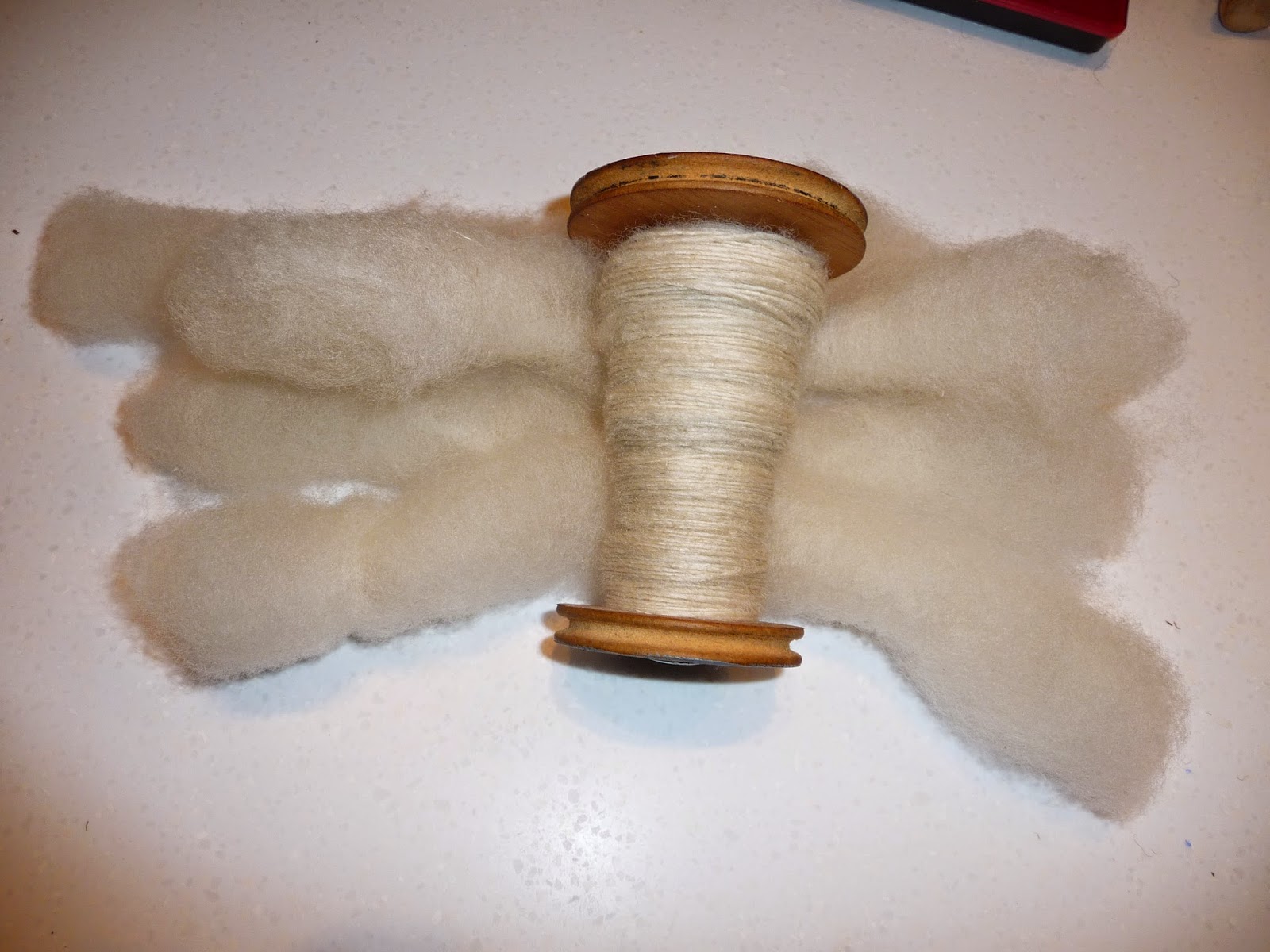If a sheep's fleece felts while it is still on the animal's back, this is called cotting. When I visited a local farm to pick out a couple of fleeces from a pile in the shed, a young man was draped over the gate looking knackered, having been set to shearing a cotted sheep. The older blokes were laughing like drains, holding the matted thing up in a solid sheet. I didn't choose that one.
I did get the general idea that the Northern Mule crosses living on the farm had fleece that felted easily. This white one is the Northern Mule X Suffolk that restarted my fermented suint vat this summer and plenty of it was open and not too grubby. The staple length varied between 7 and 12cm, fibres being medium soft to coarse with hairy areas, particularly on the britch.
Areas of the neck, belly and tail were shorter in staple and had actually cotted. Skirting the fleece, it was easy enough to pull them away from round the edges along with the worst of the muck, before putting the whole thing into the vat for a week of cold soaking. I used the waste wool to line hanging baskets, think I'll stick to using coloured fleece in future.
 Earth is a fine thing inside a container. When it rinsed through to the outside of this one, the whole thing just looked dirty.
Earth is a fine thing inside a container. When it rinsed through to the outside of this one, the whole thing just looked dirty.It is heat and friction that causes wool to felt. The open locks above are a tribute to the marvels of the suint vat.
After three cold rinses with no agitation, this fleece was still full of lanolin, but in fair condition for spinning in the grease, if you are not too picky about such things. It spent the summer rolled up in an old duvet, hidden under the spare bed. Time to fetch it out, as I promised Gwyn the farmer a hat for Christmas.
 The locks carded out nicely into rolags, stiff working against the drag of the lanolin, but easy to spin into yarn around 10 wraps per inch, trying to match the twist in the singles to the crimp in the locks.
The locks carded out nicely into rolags, stiff working against the drag of the lanolin, but easy to spin into yarn around 10 wraps per inch, trying to match the twist in the singles to the crimp in the locks.I spun some singles as fine as I could and made three ply yarn as well as the two ply shown on the ruler. The skeins were scoured by heating up to about 80 degrees Centigrade with plenty of detergent, then knitted into swatches. In the photo, the paper in the back ground has a black outline drawn around the swatches before the machine wash. You can see that the two ply only shrank marginally in a delicates 30 degree cycle, while a 60 degree Centigrade cottons wash contracted the three ply much more, making a dense fabric. The third sample shows the effect of a hot wash after knitting the yarn without scouring it first. Although the wool is a bit claggy and doesn't slip smoothly along the needles, this cuts out the scouring phase and the resulting fabric was a thick, textured, lustrous felt.
Of course, calculating the size I'd have to knit to end up with a standard hat after felting was never going to be very precise. Assuming a 58cm male head circumference and anticipating that the felt wouldn't stretch much, I thought a 56cm hat should be snug. Guided by the small swatch, I worked out this needed
130 stitches to cast on, using a 6mm circular needle. The hat looked gargantuan, but press on in hope. Working a band in purl, then knitting until the tube measured 24cm, I shaped the crown in the classic fashion by dividing the number of stitches by five and placing a marker every 26 stitches. Knitting two together through the back of the loop before each marker and knitting
 two together after each marker reduces the stitch count by 10 on each round and I guesstimated two plain rounds between each reduction round to give a proportionate dome. Once through a 60 degree cycle and the length was right, but the circumference too loose. Washed again, the circumference was right, but the hat became a skimpy beanie.
two together after each marker reduces the stitch count by 10 on each round and I guesstimated two plain rounds between each reduction round to give a proportionate dome. Once through a 60 degree cycle and the length was right, but the circumference too loose. Washed again, the circumference was right, but the hat became a skimpy beanie.It has to be the warmest knitwear Gwyn will get this Christmas, half an inch thick, practically. Next time, I shall knit a better swatch for felting calculations.
I name it
The Cotted Cap.










Clever you, am loving your blog, thanks
ReplyDeleteThanks :) much appreciated.
DeleteThese are adorale
ReplyDeleteThanks :)
Delete